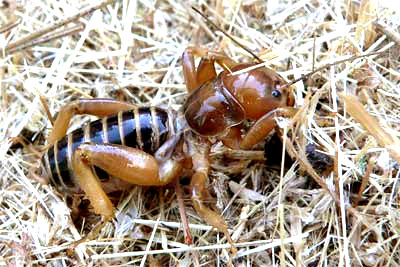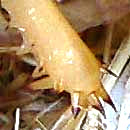Excerpts from Jim Conrad's
Naturalist Newsletter
from the July 17, 2005 Newsletter issued from California's Sierra Nevada Foothills, USA
JERUSALEM CRICKET = POTATO BUG

Friday I was raking up recently cut grass to place as mulch in the garden when beneath a big pile I uncovered one of the strangest looking insects I've ever seen. It's shown above. It was nearly two inches long, brownish, thick bodied, wingless, and I'd simply never seen such a thing before.  Often I find tiny flies or mites that are new to me, but hardly ever does something this large and unknown come along. At the right you can see the interesting spines on its back leg.
Often I find tiny flies or mites that are new to me, but hardly ever does something this large and unknown come along. At the right you can see the interesting spines on its back leg.
It almost looked like a cricket so I went to the cricket pages of my old Peterson fieldguide and there it was: It was a Jerusalem Cricket of the Camel Cricket Family, the Gryllacrididae. That's a different family from the one to which house crickets and field crickets belong, the Gryllidae.
Knowing that, I was further able to identify it on the Internet as STENOPELMATUS FUSCUS*.
Jerusalem Crickets are nocturnal and their big heads bear powerful mandibles that not only serve them as they prey on spiders and many kinds of insects, but also for biting fingers!
I went to show Fred and Diana my discovery and of course they'd seen them before. In North America Jerusalem crickets are western, occurring chiefly along the Pacific Coast, so no wonder they were new to me.
Fred said he'd always called them Potato Bugs, maybe because they're brown and so plump. I like the Spanish name better, Niña de la Tierra, meaning "Little Girl of the Earth," probably because of the cricket's oversized head and rounded body.
When I told my friend Buck about finding a Potato Bug he said I should see how much fun chickens have with them. They just love those big, juicy morsels, but sometimes a Potato Bug gets its claws around the hen's beak, and Buck demonstrated how the hen would run around shaking her head back and forth trying to sling that insect off.